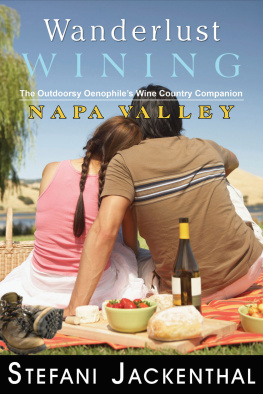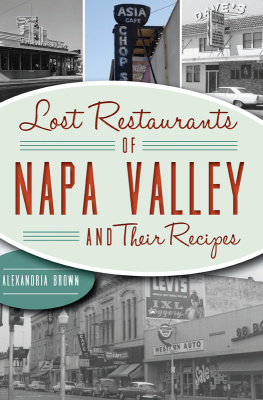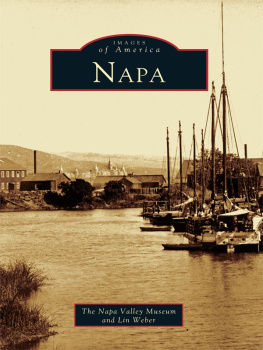
FOOD LOVERS
GUIDE TO
NAPA VALLEY
Help Us Keep This Guide Up to Date
We would love to hear from you concerning your experiences with this guide and how you feel it could be improved and kept up to date. Please send your comments and suggestions to:
editorial@GlobePequot.com
Thanks for your input, and happy travels!
To buy books in quantity for corporate use or incentives, call (800) 9620973 or e-mail premiums@GlobePequot.com.

Copyright 2012 Morris Book Publishing, LLC
ALL RIGHTS RESERVED. No part of this book may be reproduced or transmitted in any form by any means, electronic or mechanical, including photocopying and recording, or by any information storage and retrieval system, except as may be expressly permitted in writing from the publisher. Requests for permission should be addressed to Globe Pequot Press, Attn: Rights and Permissions Department, PO Box 480, Guilford, CT 06437.
Editor: Amy Lyons
Project Editor: Lynn Zelem
Layout Artist: Mary Ballachino
Text Design: Sheryl Kober
Illustrations Jill Butler with additional art by Carleen Moira Powell and MaryAnn Dub
Map: Daniel Lloyd Morris Book Publishing, LLC
ISBN 978-0-7627-7315-2
Printed in the United States of America
10 987654321
All the information in this guidebook is subject to change. We recommend that you call ahead to obtain current information before traveling.
About the Author
Jean Saylor Doppenberg has been eating her way through Californias Wine Country in generaland Napa Valley in particularfor more than two decades. Though the legendary 9-course, sit-down dinner at the French Laundry still eludes her, she has nonetheless logged several thousand miles exploring the renowned Valley to partake of its burgers, burritos, biscotti, and brownies. She is the author of Insiders Guide to Californias Wine Country (Globe Pequot Press), and has also written about food for the Napa Valley Register. Jean lives in Sonoma County, Napas neighbor.
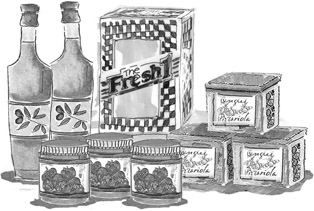
Acknowledgments
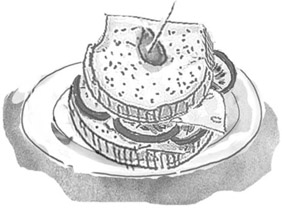
Keeping track of whom to thank for helping me write this first edition was not an easy task. Ive interviewed so many people along the way. Many stand out, however, for their insider knowledge and years of experience running wineries, cheffing, baking, farming, conducting business, and living in Napa Valley.
The following friendly people were gracious with their time and patience, even while I was asking the nitpicky questions: Mary Jo Geitner, Marie Bianco, Tyffani Peters, Annie Baker, Julie Ann Kodmur, Sally and Jeff Manfredi, Kim Daniels, Patti McBride, Colette Hatch, Spencer Reid, Summer Sebastiani, Steve Sando, Ken and Susie Pope, Joanne Blicker, Eric G. Hensel, Lana Richardson, Carrie Baker, Craig DiFonzo, Michael Cope, Chris Aken, David Zurowski, Sandy Dominguez, Dominic Orsini, Ethan Bier, Gillian and Nick Kite, Laddie Hall, Sommer Woolley, Bob Hattich, Lynn Brown, Barbara Clerici, Mark Haberger, Maria Haug, Brad Gates, Lizzie Moore, Sherri Hurley, Cathy Hammond, Diane Padoven, Beth Ponder, Katrina Kirkham, Sally Wood, Sandra Barros, Melissa Welles, Sean Knight, and Bertram Whitman.
Thanks also to my husband, Loren, and my sister, Jan Blanchard, who shared in some of my exhaustive fact-gathering and food-devouring trips up and down the Valleyall in the name of research. I also appreciate the many friends who weighed in with their opinions and advice, and provided the cheerleading and the laughter necessary to keep me going: Jan, Mariann, Donna, Julia, Pat, Cathy, Kathy K., Lynn, Kathy M., Linda, Karen, Doris, Sandy, Phyllis, Michele, Ed, Riki, Nancy, Connie, Sue, and Monica. And to Mom and Dad, thanks for all those great home-cooked meals.
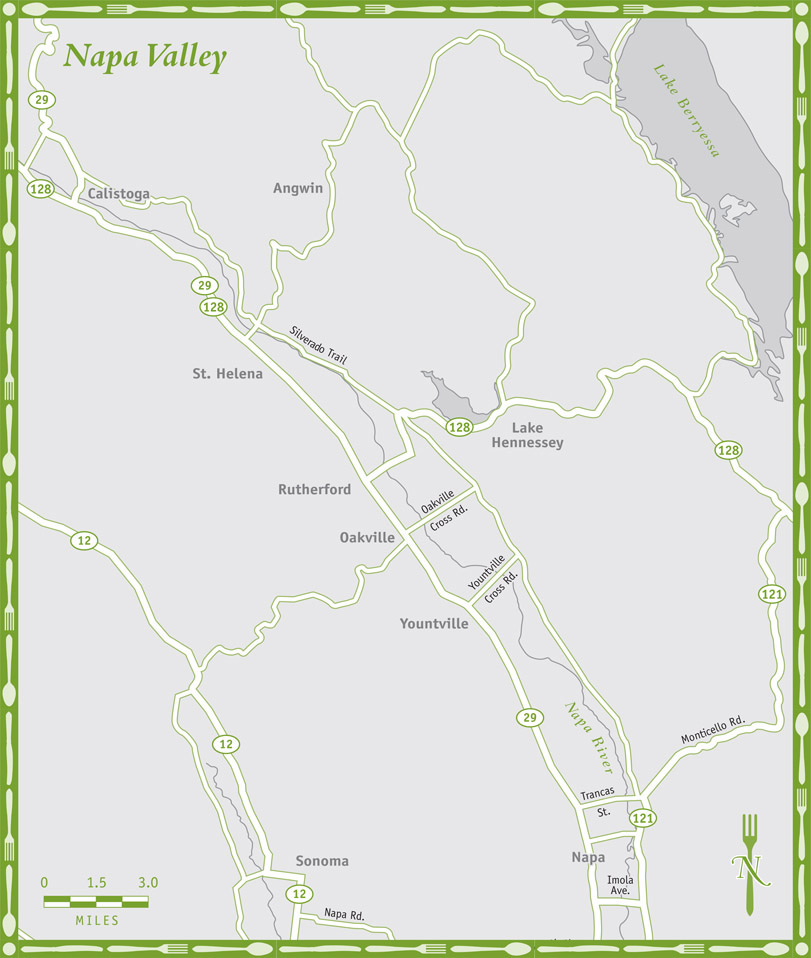
Introduction
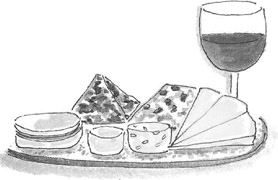
If youre reading this book, you probably adore good wine in addition to loving food. In fact, you might argue that wine is food. Many people believe a great meal cannot be enjoyed without wine, and wine cannot be consumed without food. Its a symbiotic relationship that dates back several millennia; the first archaeological evidence of wine production is from 8,000 years ago in Eurasia.
In Napa Valley, winemaking has been going on for considerably less timenot yet 200 years. An early settler, George Yount (Yountville is named after him), first began to grow grapes in the mid-1800s. Nearly all of the wine grapes George and his peers produced at that time were crushed into simple jug wines.
Fast-forward a century, to the 1960s. Business mavericks such as Robert Mondavi led the charge for attracting visitors to Napa Valley by the thousands and marketing the region like crazy. A fearless and tireless self-promoter, Mondavi built a sleek, California mission-style winery in Oakville and gave away free tastes of his product (alas, tasting is no longer free). Following quickly in his footsteps were scores of visionaries who designed and erected wineries to matchor surpassthose found in France, Italy, and Germany. More showplace wineries have opened for business in the last 25 years. Consequently, much of what you see as you drive through Napa Valley is relatively new.
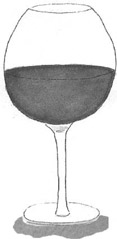
For more than 50 years, the wine grape has been the engine driving the economy of Napa Valley. Before that, orchards of fig and walnut trees were plentiful, along with fields of wheat, and wine grapes made up only about a third of the crops grown. As the decades ticked away, orchards were cut down in favor of vineyards, and the price of farmland crept ever upward, making it economically impractical to grow anything but profitable wine grapes. In 2000, a golf course along the Silverado Trail was even plowed under to make way for more Cabernet Sauvignon grapesNapa Valleys star varietal. The frenzy to plant vineyards reached a crescendo in the early 2000s, and premium wine grapes now account for 98 percent of the agriculture in the Valley.
Twenty years ago, even as visitors were coming by the millions to view the vineyards and pack the tasting rooms, world-class dining experiences were few and far between. But now there are so many great options, its difficult to choose between them. High-profile chefs such as Thomas Keller, Cindy Pawlcyn, Ken Frank, Michael Chiarello, Richard Reddington, Christopher Kostowand more recently Tyler Florence and Masaharu Morimotohave helped Napa Valley evolve into one of Americas leading culinary destinations.
How to Use This Book
Organized into five chapters, this guide begins with the city of Napa at the south end of Napa Valley. This first chapter also includes a few attractions south of the city, as well as the restaurants, farms, and food-and-wine pairing opportunities found in the Carneros wine-growing district southwest of Napa.
Next page


